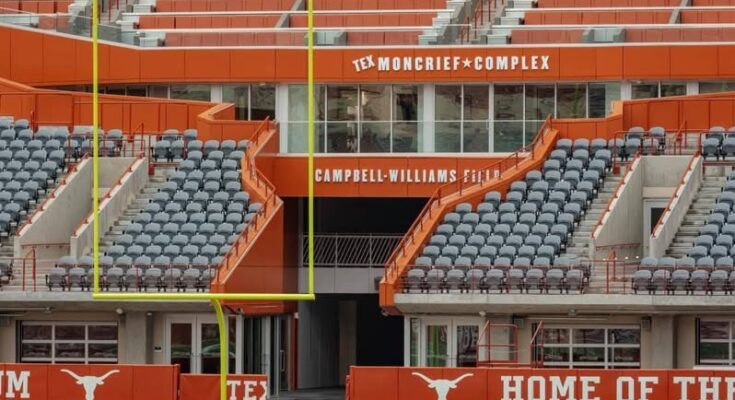The University of Texas at Austin’s beloved Darrell K. Royal–Texas Memorial Stadium is about to undergo one of the most significant transformations in its storied history, ushering in a new era for Longhorn Nation. With a staggering \$175 million investment dedicated to a comprehensive stadium expansion, the project promises not only to enhance the game-day experience for fans but also to provide state-of-the-art facilities for athletes. Central to the renovation is the full enclosure of the stadium’s south end zone, a move that will not only elevate the venue’s aesthetic but also increase seating capacity and create a more immersive, intimidating atmosphere for visiting teams. The potential future seating capacity is projected to reach an astonishing 112,000, firmly positioning Texas Memorial Stadium among the largest and most formidable college football venues in the nation.
This ambitious undertaking signals the University of Texas’s commitment to maintaining its status as a premier football powerhouse and ensuring that its facilities reflect the program’s rich tradition and ongoing competitive aspirations. Over the decades, Texas Memorial Stadium has been a hallowed ground for Longhorn football, bearing witness to countless thrilling victories, legendary players, and passionate fans clad in burnt orange. However, like many historic stadiums, it has faced the inevitable challenge of modernization as college football has evolved into a spectacle demanding not only superior athletic performance but also a top-tier fan experience. The \$175 million project addresses these needs with meticulous planning and cutting-edge design, ensuring that the stadium’s future is as bright as its past.
At the heart of the expansion is the full enclosure of the south end zone. Historically, the stadium has featured open end zones that, while allowing for stunning views of the Austin skyline and a unique architectural style, have limited seating options and game-day atmosphere enhancements. Enclosing the south end zone transforms the stadium into a fully enclosed bowl, improving sightlines for spectators and creating a unified environment that amplifies crowd noise and energy. This architectural shift is expected to elevate the home-field advantage significantly, turning Texas Memorial Stadium into a fortress where opposing teams feel the roar of Longhorn fans from every angle.
Beyond the structural changes, the project incorporates the latest advancements in athlete and fan facilities, reflecting modern expectations for comfort, convenience, and functionality. For the athletes, this means access to cutting-edge training rooms, recovery centers, locker rooms, and meeting spaces designed to foster team cohesion and prepare players physically and mentally for competition. These upgraded facilities will provide Longhorn players with the tools necessary to excel, reinforcing the University’s commitment to athlete welfare and performance excellence.
Fan experience enhancements are equally ambitious. The expansion includes new premium seating options, modern concourses with improved food and beverage offerings, upgraded restrooms, and expanded merchandise areas. Technology integration is also a priority, with plans for enhanced Wi-Fi connectivity, larger video boards, and immersive sound systems that keep fans engaged throughout the game. Tailgating, a cherished Texas tradition, will benefit from improved access points and amenities that make arriving and departing smoother and more enjoyable. These comprehensive upgrades aim to make every visit to Darrell K. Royal–Texas Memorial Stadium a memorable event, whether for a die-hard Longhorn fan or a first-time visitor.
The increased seating capacity to a potential 112,000 fans is one of the most exciting prospects of the expansion. This growth not only symbolizes Texas’s football prominence but also opens doors to hosting larger and more prestigious events, including playoff games, bowl games, and neutral-site matchups that require substantial seating. A stadium of this magnitude will boost the University’s profile on the national stage, attracting recruits, media attention, and generating significant economic benefits for the Austin area. Local businesses, hospitality, and tourism sectors stand to gain from the influx of visitors drawn by high-profile games in a world-class facility.
Financing a \$175 million project of this scale requires careful planning and collaboration between the University, donors, sponsors, and possibly public funding mechanisms. The investment reflects confidence in the program’s future and a shared vision among stakeholders to keep Texas football at the forefront of college athletics. Naming rights, premium seat packages, and other revenue-generating initiatives are likely components of the funding strategy, ensuring the stadium’s expansion remains financially sustainable while delivering maximum value to fans and the University community.
The timing of this transformation is particularly noteworthy. College football has seen rapid growth in popularity, viewership, and revenue in recent years, driven by factors such as expanded playoff systems, lucrative broadcasting deals, and an ever-growing fan base. Texas, with its passionate supporters and historic program, stands poised to capitalize on these trends by offering a stadium experience that matches the excitement and intensity of the game itself. As rival programs also upgrade their facilities, the Longhorns’ expansion is crucial to maintaining competitive parity and demonstrating a commitment to excellence on and off the field.
Moreover, the project aligns with broader University goals, including sustainability and community engagement. Modern stadium designs increasingly incorporate eco-friendly materials, energy-efficient systems, and waste reduction initiatives. While specific details are still emerging, it is anticipated that the Texas Memorial Stadium expansion will integrate such features to minimize its environmental footprint and contribute positively to campus and city sustainability efforts. Community access, including events beyond football games, may also be enhanced by the upgraded facilities, fostering stronger ties between the University and the broader Austin community.
In terms of construction logistics, the project will likely be executed in phases to minimize disruption to the football schedule and campus activities. Maintaining the stadium’s usability during the build will require careful coordination among architects, contractors, and University officials. Safety, accessibility, and continuity of operations are paramount considerations throughout the construction process, ensuring that fans and athletes alike experience as little inconvenience as possible.
As the expansion progresses, anticipation among Longhorn Nation continues to build. Fans eagerly await the opportunity to experience the new south end zone enclosure, enjoy premium amenities, and witness the vibrant atmosphere generated by a full-capacity crowd. The project is more than a construction effort; it represents a renewed commitment to Texas football’s enduring legacy, a bold step into the future, and a unifying moment for a community bound by pride and passion for their team.
In conclusion, the \$175 million expansion of Darrell K. Royal–Texas Memorial Stadium marks a historic milestone for the University of Texas at Austin and Longhorn Nation. By enclosing the south end zone, incorporating cutting-edge athlete and fan facilities, and preparing for a potential seating capacity of 112,000, the project redefines what it means to attend a football game in Austin. It honors the past while embracing innovation, ensuring that Texas Memorial Stadium remains a symbol of excellence, tradition, and forward-thinking vision for decades to come. This transformation not only elevates the fan experience but also strengthens the University’s position as a premier destination for top-tier college football, showcasing the power of community, sport, and shared ambition in shaping a vibrant future.



